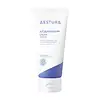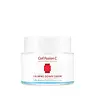What's inside
What's inside
 Key Ingredients
Key Ingredients

 Benefits
Benefits

 Concerns
Concerns

 Ingredients Side-by-side
Ingredients Side-by-side

Water
Skin ConditioningButylene Glycol
HumectantGlycerin
HumectantButylene Glycol Dicaprylate/Dicaprate
EmollientCetyl Ethylhexanoate
EmollientSqualane
EmollientPentaerythrityl Tetraisostearate
EmollientDicaprylyl Carbonate
EmollientBehenyl Alcohol
EmollientDimethicone
EmollientHydroxypropyl Bispalmitamide Mea
EmollientStearic Acid
CleansingBetaine
HumectantMannitol
HumectantC14-22 Alcohols
Emulsion StabilisingPalmitic Acid
EmollientHydroxypropyl Bislauramide Mea
EmollientArachidyl Alcohol
EmollientCholesterol
EmollientPolyacrylate-13
C12-20 Alkyl Glucoside
EmulsifyingAllantoin
Skin ConditioningArachidyl Glucoside
EmulsifyingNiacinamide
SmoothingCeramide NP
Skin ConditioningGlyceryl Caprylate
EmollientEthylhexylglycerin
Skin ConditioningHydrogenated Polyisobutene
EmollientCarbomer
Emulsion StabilisingTromethamine
BufferingDimethiconol
EmollientPolyglyceryl-10 Laurate
Skin ConditioningHydrogenated Lecithin
EmulsifyingEthylhexyl Palmitate
EmollientAcrylates/Ammonium Methacrylate Copolymer
Sorbitan Isostearate
EmulsifyingSilica
AbrasivePhytosphingosine
Skin ConditioningSphingolipids
EmollientArachidic Acid
CleansingTocopherol
AntioxidantOleic Acid
EmollientWater, Butylene Glycol, Glycerin, Butylene Glycol Dicaprylate/Dicaprate, Cetyl Ethylhexanoate, Squalane, Pentaerythrityl Tetraisostearate, Dicaprylyl Carbonate, Behenyl Alcohol, Dimethicone, Hydroxypropyl Bispalmitamide Mea, Stearic Acid, Betaine, Mannitol, C14-22 Alcohols, Palmitic Acid, Hydroxypropyl Bislauramide Mea, Arachidyl Alcohol, Cholesterol, Polyacrylate-13, C12-20 Alkyl Glucoside, Allantoin, Arachidyl Glucoside, Niacinamide, Ceramide NP, Glyceryl Caprylate, Ethylhexylglycerin, Hydrogenated Polyisobutene, Carbomer, Tromethamine, Dimethiconol, Polyglyceryl-10 Laurate, Hydrogenated Lecithin, Ethylhexyl Palmitate, Acrylates/Ammonium Methacrylate Copolymer, Sorbitan Isostearate, Silica, Phytosphingosine, Sphingolipids, Arachidic Acid, Tocopherol, Oleic Acid
Water
Skin ConditioningGlycerin
HumectantMethylpropanediol
SolventMethyl Trimethicone
Skin Conditioning1,2-Hexanediol
Skin ConditioningIsodecyl Neopentanoate
EmollientHydrogenated Polyisobutene
EmollientAmmonium Acryloyldimethyltaurate/Vp Copolymer
Trehalose
HumectantAlgae Extract
EmollientEclipta Prostrata Leaf Extract
Skin ConditioningMelia Azadirachta Flower Extract
Skin ConditioningMelia Azadirachta Leaf Extract
Skin ConditioningMelaleuca Alternifolia Leaf Extract
PerfumingOcimum Sanctum Leaf Extract
Skin ConditioningCurcuma Longa Root Extract
MaskingMalt Extract
Skin ProtectingCentella Asiatica Extract
CleansingCoccinia Indica Fruit Extract
Skin ConditioningPueraria Lobata Root Extract
HumectantAloe Barbadensis Leaf Extract
EmollientChlorella Minutissima Extract
Skin ConditioningPortulaca Oleracea Extract
Skin ConditioningCorallina Officinalis Extract
Skin ConditioningSolanum Melongena Fruit Extract
Skin ConditioningAloe Barbadensis Flower Extract
EmollientRosmarinus Officinalis Leaf Extract
AntimicrobialAnthemis Nobilis Flower Extract
MaskingUlmus Davidiana Root Extract
Skin ConditioningAmaranthus Caudatus Seed Extract
Skin ConditioningAvena Sativa Kernel Extract
AbrasivePteris Multifida Extract
AntioxidantArtemia Extract
Skin ConditioningUndaria Pinnatifida Extract
Skin ConditioningLepidium Meyenii Root Extract
Skin ConditioningCitrus Nobilis Peel Extract
MaskingChrysanthemum Parthenium Extract
Skin ConditioningPinus Pinaster Bark Extract
AntioxidantSimmondsia Chinensis Seed Oil
EmollientHydrogenated Lecithin
EmulsifyingSodium Hyaluronate
HumectantTitanium Dioxide
Cosmetic ColorantCetearyl Olivate
Sorbitan Olivate
EmulsifyingPolyglyceryl-10 Laurate
Skin ConditioningButylene Glycol
HumectantPolyglyceryl-2 Caprate
EmulsifyingAllantoin
Skin ConditioningSucrose Stearate
EmollientFructooligosaccharides
HumectantStearic Acid
CleansingMethyl Diisopropyl Propionamide
MaskingAlumina
AbrasiveBeta-Glucan
Skin ConditioningGlyceryl Caprylate
EmollientPolyquaternium-51
Skin ConditioningSqualane
EmollientHydrolyzed Hyaluronic Acid
HumectantMaltodextrin
AbsorbentSaccharide Hydrolysate
HumectantCeramide NP
Skin ConditioningCholesterol
EmollientCholesteryl Macadamiate
EmollientPalmitic Acid
EmollientGuaiazulene
AntimicrobialSaccharide Isomerate
HumectantHydrolyzed Lupine Protein
Skin ConditioningParfum
MaskingAlpha-Isomethyl Ionone
PerfumingWater, Glycerin, Methylpropanediol, Methyl Trimethicone, 1,2-Hexanediol, Isodecyl Neopentanoate, Hydrogenated Polyisobutene, Ammonium Acryloyldimethyltaurate/Vp Copolymer, Trehalose, Algae Extract, Eclipta Prostrata Leaf Extract, Melia Azadirachta Flower Extract, Melia Azadirachta Leaf Extract, Melaleuca Alternifolia Leaf Extract, Ocimum Sanctum Leaf Extract, Curcuma Longa Root Extract, Malt Extract, Centella Asiatica Extract, Coccinia Indica Fruit Extract, Pueraria Lobata Root Extract, Aloe Barbadensis Leaf Extract, Chlorella Minutissima Extract, Portulaca Oleracea Extract, Corallina Officinalis Extract, Solanum Melongena Fruit Extract, Aloe Barbadensis Flower Extract, Rosmarinus Officinalis Leaf Extract, Anthemis Nobilis Flower Extract, Ulmus Davidiana Root Extract, Amaranthus Caudatus Seed Extract, Avena Sativa Kernel Extract, Pteris Multifida Extract, Artemia Extract, Undaria Pinnatifida Extract, Lepidium Meyenii Root Extract, Citrus Nobilis Peel Extract, Chrysanthemum Parthenium Extract, Pinus Pinaster Bark Extract, Simmondsia Chinensis Seed Oil, Hydrogenated Lecithin, Sodium Hyaluronate, Titanium Dioxide, Cetearyl Olivate, Sorbitan Olivate, Polyglyceryl-10 Laurate, Butylene Glycol, Polyglyceryl-2 Caprate, Allantoin, Sucrose Stearate, Fructooligosaccharides, Stearic Acid, Methyl Diisopropyl Propionamide, Alumina, Beta-Glucan, Glyceryl Caprylate, Polyquaternium-51, Squalane, Hydrolyzed Hyaluronic Acid, Maltodextrin, Saccharide Hydrolysate, Ceramide NP, Cholesterol, Cholesteryl Macadamiate, Palmitic Acid, Guaiazulene, Saccharide Isomerate, Hydrolyzed Lupine Protein, Parfum, Alpha-Isomethyl Ionone
 Reviews
Reviews

Ingredients Explained
These ingredients are found in both products.
Ingredients higher up in an ingredient list are typically present in a larger amount.
Allantoin is a soothing ingredient known for its protective and moisturizingg properties. Because of this, it is often added to products with strong active ingredients.
Studies show higher concentrations of this ingredient can promote wound healing.
Though it can be derived from the comfrey plant, allantoin is produced synthetically for cosmetic products to ensure purity.
Learn more about AllantoinButylene Glycol (or BG) is used within cosmetic products for a few different reasons:
Overall, Butylene Glycol is a safe and well-rounded ingredient that works well with other ingredients.
Though this ingredient works well with most skin types, some people with sensitive skin may experience a reaction such as allergic rashes, closed comedones, or itchiness.
Learn more about Butylene GlycolCeramide NP is a type of ceramide and formally known as ceramide 3.
Ceramides are intercellular lipids naturally found in our skin that bonds dead skin cells together to create a barrier. They are known for their ability to hold water and thus are a great ingredient for dry skin.
Ceramides are an important building block for our skin barrier. A stronger barrier helps the skin look more firm and hydrated. By bolstering the skin ceramides act as a barrier against irritating ingredients. This can help with inflammation as well.
If you would like to eat ceramides, sweet potatoes contain a small amount.
Read more about other common types of ceramides here:
Ceramide AP
Ceramide EOP
Cholesterol is a class of organic molecules called lipids. It helps hydrate your skin and is essential to having a healthy skin barrier.
Our skin naturally contains cholesterol in the outermost layer. Besides cholesterol, it also contains ceramides and fatty acids. Cholesterol makes up about 1/4 of your skin's outer layer and barrier. Your skin barrier is responsible for keeping allergens and microbes out. Having a healthy skin barrier is also responsible for keeping your skin firm and plump.
Our bodies use cholestrol to create vitamin D, steroid hormones, and more.
Learn more about CholesterolGlycerin is already naturally found in your skin. It helps moisturize and protect your skin.
A study from 2016 found glycerin to be more effective as a humectant than AHAs and hyaluronic acid.
As a humectant, it helps the skin stay hydrated by pulling moisture to your skin. The low molecular weight of glycerin allows it to pull moisture into the deeper layers of your skin.
Hydrated skin improves your skin barrier; Your skin barrier helps protect against irritants and bacteria.
Glycerin has also been found to have antimicrobial and antiviral properties. Due to these properties, glycerin is often used in wound and burn treatments.
In cosmetics, glycerin is usually derived from plants such as soybean or palm. However, it can also be sourced from animals, such as tallow or animal fat.
This ingredient is organic, colorless, odorless, and non-toxic.
Glycerin is the name for this ingredient in American English. British English uses Glycerol/Glycerine.
Learn more about GlycerinGlyceryl Caprylate comes from glycerin and caprylic acid, a fatty acid from coconut. It has emollient and emulsifier properties.
As an emollient, it helps hydrate your skin. Emollients work by creating a barrier on your skin to trap moisture in, helping to keep your skin soft and smooth.
On the other hand, emulsifiers prevent ingredients (such as oil and water) from separating.
Learn more about Glyceryl CaprylateHydrogenated Lecithin is created from the hydrogenation of lecithin (a group of phospholipids). Hydrogenation is a chemical reaction between hydrogen and another element.
This ingredient is an emollient and emulsifier. As an emollient, it helps soften skin by trapping moisture within. As an emulsifier, it prevents oil and water ingredients from separating.
Hydrogenated Polyisobutene is a synthetic polymer. Polymers are compounds with high molecular weight. Hydrogenated Polyisobutene is an emollient and texture enhancer.
In one study, Hydrogenated Polyisobutene showed better skin hydration levels than Caprylic/Capric Triglyceride. As an emollient, it helps keep your skin soft and hydrated by trapping moisture in.
Hydrogenated Polyisobutene is often used as a mineral oil replacement.
Learn more about Hydrogenated PolyisobutenePalmitic Acid is a fatty acid naturally found in our skin and in many plant and animal sources. In cosmetics, it is usually derived from palm oil. It serves many purposes in skincare, acting as a cleanser, emollient, and emulsifier.
As an emollient, palmitic acid helps soften and smooth the skin by preventing water loss. In cleansers, it helps remove oil and dirt while creating foam.
Its emulsifying properties help stabilize products by keeping water and oil-based ingredients from separating.
This may not be suitable for fungal acne-prone skin, as fatty acids like this can sometimes trigger breakouts in sensitive individuals.
Learn more about Palmitic AcidPolyglyceryl-10 Laurate is an ester of lauric acid and Polyglycerin-10.
Polyglyceryl-10 Laurate is a cleansing agent and emulsifier. It helps gather dirt, oil, and other pollutants to be rinsed away. As an emulsifier, it helps prevent ingredients from separating, such as oil and water.
Polyglyceryl-10 Laurate may not be fungal acne safe.
Learn more about Polyglyceryl-10 LaurateSqualane is an emollient that helps the skin hold onto moisture. It's an oily liquid that occurs naturally in certain types of fish and plant oils.
Because squalane boosts hydration in the skin, it also comes with plenty of benefits: it is an antioxidant and can help fight free radicals and skin damage. Squalane is also found to have a detoxifying effect when applied.
Squalane comes from squalene, which occurs naturally within the sebum of our skin. It is one of the oils our skin produces to keep itself hydrated. Squalane is the hydrogenated version of squalene and has a longer shelf life.
Research shows that squalane is non-irritating (even at 100% concentration).
In general, it's a fantastic ingredient. It does a great job at hydrating the skin, and it's suitable for those with sensitive skin.
The source of squalane may impact malassezia / fungal acne. This is because olive oil derived squalane can contain impurities such as fatty acids and plant waxes. Sugarcane derived squalane is recommended for anyone with malassezia concerns.
Is squalane vegan?
This depends on the source. Squalane can be derived from both plants and animals. Most squalane used in skincare comes from plants.
Please note: the source of squalane is only known if disclosed by the brand. We recommend reaching out to the brand if you have any questions about their squalane.
Read more about squalene with an "e".
Is squalane an oil?
Squalane is often called an oil, but it’s technically not; it’s a hydrocarbon, meaning it’s only made of carbon and hydrogen, unlike true oils which are triglycerides made of fatty acids and glycerol.
The term “oil-free” isn’t regulated, so companies can define it however they want. Some exclude all oils, while others just avoid mineral oil or comedogenic oils.
While some people avoid oils thinking they cause breakouts, the right kind of oil (or oil-like ingredient like squalane) can actually help balance and hydrate your skin. It’s worth testing out simple oils or squalane to see what works best for your skin.
Learn more about SqualaneStearic Acid is a fatty acid. It is an emollient, emulsifier, and texture enhancer.
As an emollient, stearic acid helps soften skin. It aids the skin's protective barrier by preventing water loss. It also provides a gentle cleansing effect without stripping away natural oils.
Stearic acid may also be used to enhance the texture of products. It can add volume and stabilize ingredients such as water and oil. This can help water and oil ingredients from separating.
Sources of stearic acid include animal or vegetable fats/oils such as coconut or shea. It can be naturally found in butter, cocoa butter, shea butter, vegetable fats, and animal tallow.
This ingredient may not be Malassezia folliculitis, or fungal-acne safe.
Learn more about Stearic AcidWater. It's the most common cosmetic ingredient of all. You'll usually see it at the top of ingredient lists, meaning that it makes up the largest part of the product.
So why is it so popular? Water most often acts as a solvent - this means that it helps dissolve other ingredients into the formulation.
You'll also recognize water as that liquid we all need to stay alive. If you see this, drink a glass of water. Stay hydrated!
Learn more about Water